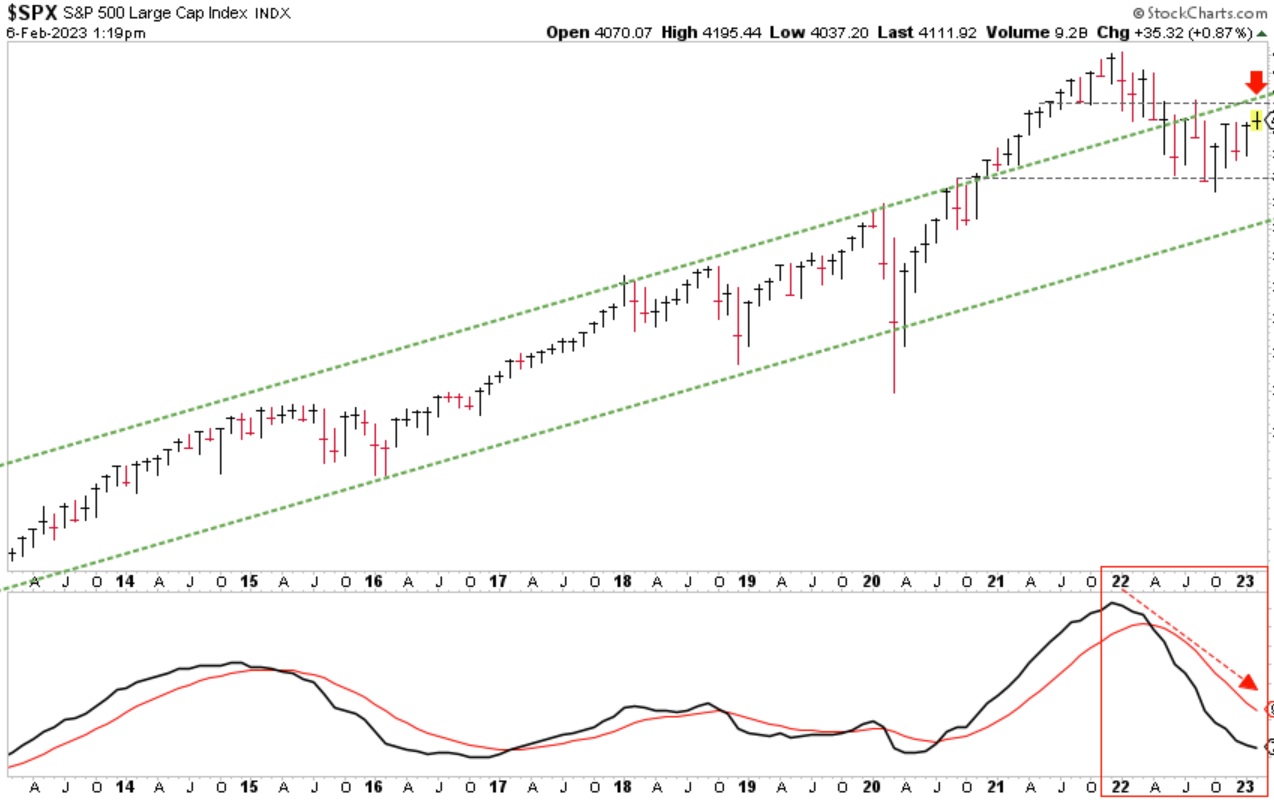During January, the US stock markets staged a price rally, primarily driven by stocks in the technology sector. This helped the S&P 500 and NASDAQ stock indices rally while the Dow Jones Industrial Average remained relatively flat. As can be seen in the chart below, at the end of January the S&P 500 Index began rising above both the Blue Line and the top downward-sloping red dashed line.
PRIMARY TREND: RISING

Chart courtesy of StockCharts.com
The S&P finished the month of January 2.00% above the Blue Line, compared to 4.01% below the Blue Line at the end of December. Price has rallied above the Blue Line, which, according to our investment process is encouraging.
THE “BLUE LINE”: A CLOSER LOOK

Chart courtesy of StockCharts.com
CONTINUED CAUTION?
However, I want to post the chart below to show one reason why I continue to remain cautious. Where many investors make mistakes is when they react to price movements. When prices rise, they believe all is well. When they decline, they believe all is not well. The truth is the markets tend to “trap” investors by using their emotions against them.
The chart below shows a red arrow in the top right-hand corner of the chart. The recent price rally is causing price to approach the top, green-dashed line, and the top gray dashed-line. In the lower right-hand corner within the red box you can see the black line is still falling and remaining below the red line.

Chart courtesy of StockCharts.com
As profit-seeking investors, I do not believe it is a prudent strategy to always remain invested. Instead, I believe investors should be cautious when the markets may be suggesting caution, and greedy when the markets may be suggesting gains. Currently, the near-term picture remains unclear. While our investment strategies took final profits last month from the remaining Inverse-ETF’s purchased in early 2022, the possibility still exists that we may want to add some back shortly if conditions warrant.
Thank you for reading this condensed update. If you are not an existing client, have recently retired or are within fifteen years or retirement, and would like to learn how our process may help limit investment losses to improve your long-term results, please call (833) 258-2583.
Jeff Link
Disclaimers:
The BLUE LINE INVESTING® (BLI) investment process was founded on over 95 years of stock market history. It seeks to identify and align investment decisions with multiyear trends. Various aspects of this process have been illustrated in my book Protecting The Pig: How Stock Market Trends Reveal the Way to Grow and Preserve Your Wealth.
The S&P 500 Index is one of the most commonly followed equity indices, and many consider it one of the best representations of the U.S. stock market, and a bellwether for the U.S. economy. It is comprised of 500 large companies having common stock listed on the NYSE or NASDAQ. The volatility (beta) of the account may be greater or less than the index. It is not possible to invest directly in this index.
Technical analysis is a method of evaluating securities by analyzing statistics generated by market activity, such as past prices and volumes. Technical analysis attempts to predict a future stock price or direction based on market trends. The assumption is that the market follows discernible patterns and if these patterns can be identified then a prediction can be made. The risk is that markets may not always follow patterns. There are certain limitations to technical analysis research, such as the calculation results being impacted by changes in security price during periods of market volatility. Technical analysis is one of many indicators that may be used to analyze market data for investing purposes and should not be considered a guaranteed prediction of market activity. The opinions expressed are those of BLI. The opinions referenced are as of the date of publication and are subject to change without notice. BLI reserves the right to modify its current investment strategies based on changing market dynamics or client needs.
Past performance is not indicative of future results. This material is not financial advice or an offer to sell any product. The information contained herein should not be considered a recommendation to purchase or sell any particular security. Forward looking statements cannot be guaranteed.
Guardian Wealth Advisors, LLC (“GWA”) is an investment adviser registered with the U.S. Securities and Exchange Commission. Registration does not imply a certain level of skill or training. More information about GWA’s investment advisory services can be found in its Form CRS or Form ADV Part 2, which is available upon request.
GWA-23-17




